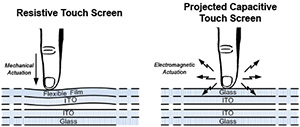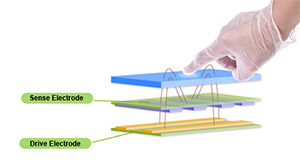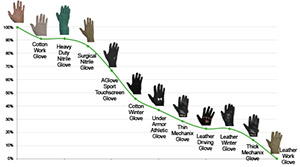Designing Touch Panels to Work with Gloves
Techniques to increase touch performance
April 2012
As projected capacitive touch panels become more popular, users are becoming increasingly familiar with one of their inherent challenges: using a projected capacitive touch panel while wearing gloves. Some companies have even made a niche market out of this challenge by selling various kinds of gloves designed specifically for use with projected capacitive touch panels.
Touch Response: Resistive vs. Projected Capacitive
The difference in touch response between a traditional resistive touch panel and a projected capacitive touch panel is based on the underlying technology used to determine the location of the touch. Unlike a resistive touch panel, which works by shorting one conductive layer to another, a projected capacitive touch panel uses capacitive coupling between the user’s finger and the touch panel to determine the location of the touch. If there is no capacitive coupling, the touch panel can’t recognize if a finger is present.
The amount of capacitive coupling between the touch panel and the user’s finger depends on two things: dielectric and distance. The dielectric of a material is essentially a measurement of how well that material conducts an electric field: the higher the dielectric, the higher the conduction. The dielectrics of the materials between the touch sensor and the user’s finger can increase the coupling when the dielectrics are high or decrease the coupling when the dielectrics are low (Figure 1). The insulating materials found in gloves often have very low dielectrics, which is one reason they don’t work well with capacitive touch panels.
While the dielectrics of the materials are important, the more important factor is distance. The further the user’s finger is from the touch panel, the less it is capacitively coupled with the touch sensor. While a high dielectric material can help to overcome distance, it can’t completely compensate for it. The thickness of the glove is the most important factor to consider when discussing the performance of a capacitive touch panel with the use of a glove.
Challenges with designing touch panels for glove use
One of the most difficult aspects of designing a projected capacitive touch panel to work with gloves is the variability of the types of gloves different users may wear. Some gloves are thin and some are thick; some gloves use solid insulating materials with a relatively high dielectric, while others are basically just giant air pockets with some insulating material for stuffing. To complicate things even further, some applications have to adapt to both bare hands and glove use.
Medical, or latex gloves, present the best scenario for glove use with projected capacitive touch panels. Most medical gloves tend to be very thin material with no insulation and they do not have a seam around the fingertips like some work gloves do. Medical gloves are all used very consistently since typically every user will be wearing the same type of glove. The combination of these factors allows the designer to tune the panel performance to a very narrow range, resulting in a very reliable and consistent user experience. In general, medical applications are typically the easiest type of glove application to deal with. This is one of the many reasons why projected capacitive touch panels are quickly becoming the default choice for medical applications.
Different applications call for different gloves
While medical devices and applications work extremely well with projected capacitive touch panels, many other touch panel applications present significant challenges for gloved use. What about the woman who is trying to use an outdoor ATM in Alaska in January? She’s probably wearing extra thick, double insulated winter gloves. Or what about the factory worker that needs to interface with the touch control panel while wearing protective gloves for safety?
Designing applications for winter gloves or work gloves is the antithesis of designing for medical applications. Winter gloves and work gloves tend to be very thick, often have large seams around the fingertips and are used inconsistently. The user may wear thin gloves in the fall and spring, thick gloves in the winter and no gloves in the summer. Even that general rule can be inconsistent.
Consider the ATM application mentioned earlier. You might think that you could dynamically tune the touch panel performance based on the time of year or even the ambient temperature by increasing the touch panel sensitivity as the temperature drops. Unfortunately that doesn’t always work. One person might drive up who just got in their car and is wearing extremely thick gloves. The person behind them might have been in their car for hours with the heat turned all the way up, so they’re not wearing any gloves. This ATM application has to work for both customers equally well.
As previously mentioned, the most important factor in the performance of a projected capacitive touch panel when used with a glove is the thickness of the glove itself. While this is true, it’s not the whole story. What really matters is not the thickness of the glove, but the distance of the user’s finger from the surface of the touch panel. If the glove is thick but compressible, then the user may be able to overcome the performance deficiency simply by pressing their finger harder on the glass, compressing the glove and moving their finger closer to the touch surface. While this technique can work, it also has several problems.
One of the biggest issues is the construction of the glove. Many gloves, work gloves in particular, have thick seams around each of the fingertips. This makes compressing the tip of the finger very difficult. Another issue is the glove material. Some gloves are pliable and deform easily when compressed; others are stiff and tend to bend rather than compress. Another factor is the fit of the glove. If the glove is too large for the user’s hand, then the user has to compress the glove even more in order to get the finger closer to the touch surface. Even if the glove does compress sufficiently, the user may have difficulty telling exactly where their finger is in relation to the user interface object they are trying to touch.
How to accommodate for multiple glove types
All these factors make it difficult to design a projected capacitive touch panel system that works consistently for all possible users. Fortunately, there are certain design techniques that can be employed to improve the user experience when working with gloves and overcome the issues that gloves may cause.
The first step in designing a projected capacitive application for glove use is to properly tune the strength of the capacitive field. This is typically done during the design phase by changing the mechanical design of the touch panel. For example, in a two plane capacitive touch panel (Figure 2), one plane acts as the driving electrode and one plane acts as the sensing electrode. Increasing the distance between the two planes increases the strength of the capacitive field beyond the top surface of the touch panel. There is a delicate balancing act between extending the field beyond the touch panel surface and increasing the self coupling within the touch panel, which can result in spurious effects like false touches.
Another option may be to increase the power output of the driving electrode. Very few touch panel controllers allow dynamic adjustment of the driving signal. Often the only way to accurately tune this parameter is to pick the appropriate touch controller at the beginning of the design.
Another way to effectively increase the field strength is to decrease the amount of materials between the user’s finger and the touch panel sensor. For example, if you want your application to work with a heavy winter glove, then you might have to reduce your original 4 mm faceplate down to just 1 mm. You might also want to consider using glass instead of plastic since glass has a much higher dielectric and therefore does a much better job of coupling the user’s finger to the electrodes. A general rule of thumb is that in order for a plastic faceplate to have the same touch performance as a glass faceplate, the plastic faceplate needs to be half as thick (Figure 3).
While the materials, controller and field strength are set at design time and are not dynamically tunable, the amount of coupling required to qualify a touch can typically be set at run time. This is done in different ways, depending on which touch controller is being used. Some controllers provide raw data to the touch panel software driver and the driver determines when a touch has been qualified. Other controllers determine when a qualified touch has occurred based on certain parameters. In either case, it is usually possible to change how a touch is qualified while the system is running.
For example, the software driver might start with a relatively low touch threshold just in case the user is wearing a glove. Once a touch is detected, the driver could suppress the touch events for a brief time while it continuously checks the reported touch level. If the touch level remains low, the driver would assume that the user is wearing a glove and it would begin generating touch events. If the reported touch level continues to rise, the driver might wait for it to stabilize, then begin qualifying touches and passing on the events. This would prevent erroneous touches being generated while the user’s finger is approaching the touch panel.
Not all gloves are created equal
One of the most important things to remember when designing a projected capacitive touch panel for glove use is that not all gloves are created equal. The user’s experience with a product depends greatly on what kind of glove they are wearing. By understanding the various factors involved, you can provide some guidance to your users on what kind of glove works best. The following graph shows some relative measurements for a variety of gloves. The measurements are normalized to a bare finger which is defined as a baseline of 100%. Each glove is then listed based on how much attenuation it had compared to the bare finger. Keep in mind that this data was collected on one type of touch panel with one type of controller for one user. The results are intended only to show a rough approximation of the relative performance of different kinds of gloves. In other words, “your mileage will vary.”
As expected, the chart shows that thicker gloves, both winter and work gloves, have the worst performance and thin latex gloves have the best performance. One interesting glove to note is the AGlove® Touchscreen glove. Unlike most of the gloves designed for touch panel use, which have conductive pads on one or two fingers, the AGlove® has silver threads throughout the entire glove. This provides excellent capacitive coupling to the entire hand, not just the fingertip. According to a recent CNN Report, the US military has selected the AGlove® as its official glove for use with projected capacitive touch panels. One of the many reasons for this selection is the enhanced capacitive coupling it provides for the entire hand.
Keep the gloves on
Gloves present unique challenges for projected capacitive touch panel use. Fortunately, with the ubiquity of projected capacitive touch panels on cell phones and tablets, and with the niche market in projected capacitive touch panel gloves, users are becoming more and more familiar with these challenges. As users become more educated about the factors that improve touch panel performance when using gloves, like thinner materials, conductive materials, etc., designers are also getting better at adapting their systems to support glove use. The combination of smarter users and informed designers will continue to improve the touch panel experience for everyone.
Contact Us for more information.








